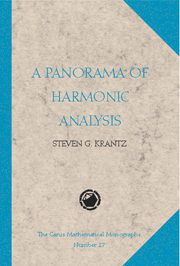Book contents
- Frontmatter
- Dedication
- Contents
- Preface
- 0 Overview of Measure Theory and Functional Analysis
- 1 Fourier Series Basics
- 2 The Fourier Transform
- 3 Multiple Fourier Series
- 4 Spherical Harmonics
- 5 Fractional Integrals, Singular Integrals, and Hardy Spaces
- 6 Modern Theories of Integral Operators
- 7 Wavelets
- 8 A Retrospective
- Appendices and Ancillary Material
- Table of Notation
- Bibliography
- Index
0 - Overview of Measure Theory and Functional Analysis
- Frontmatter
- Dedication
- Contents
- Preface
- 0 Overview of Measure Theory and Functional Analysis
- 1 Fourier Series Basics
- 2 The Fourier Transform
- 3 Multiple Fourier Series
- 4 Spherical Harmonics
- 5 Fractional Integrals, Singular Integrals, and Hardy Spaces
- 6 Modern Theories of Integral Operators
- 7 Wavelets
- 8 A Retrospective
- Appendices and Ancillary Material
- Table of Notation
- Bibliography
- Index
Summary
Pre-Basics
We take it for granted that the reader of this book has some acquaintance with elementary real analysis. The book [KRA1], or Rudin's classic [RUD1], will provide ample review.
However, the reader may be less acquainted with measure theory. The review that we shall now provide will give even the complete neophyte an intuitive understanding of the concept of measure, so that the remainder of the book may be appreciated. In fact, the reading of the present book will provide the reader with considerable motivation for learning more about measure theory.
By the same token, we shall follow the review of measure theory with a quick overview of some elementary functional analysis. Again, the reader already conversant with these ideas may consider our treatment to be a review. The beginner will gain a sufficient appreciation from this outline to be able to proceed through the rest of the book. The applications of functional analysis presented in this book—to questions about convergence of Fourier series, for instance—should serve as motivation for the reader to learn more about functional analysis.
A Whirlwind Review of Measure Theory
The motivation for measure theory on the real line ℝ is a desire to be able to measure the length of any set. At first, we only know that the length of an interval [a, b] (or [a, b) or (a, b] or (a, b)) is b − a.
- Type
- Chapter
- Information
- A Panaroma of Harmonic Analysis , pp. 1 - 30Publisher: Mathematical Association of AmericaPrint publication year: 1999



